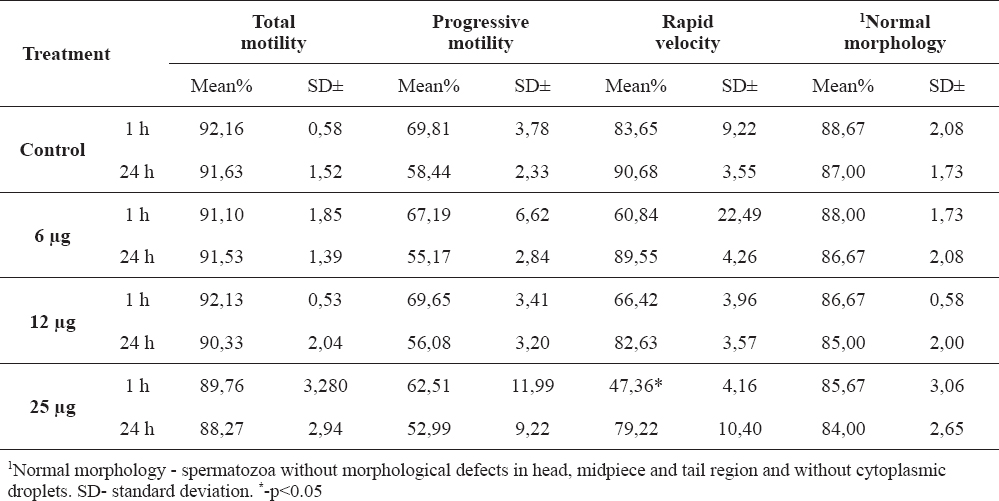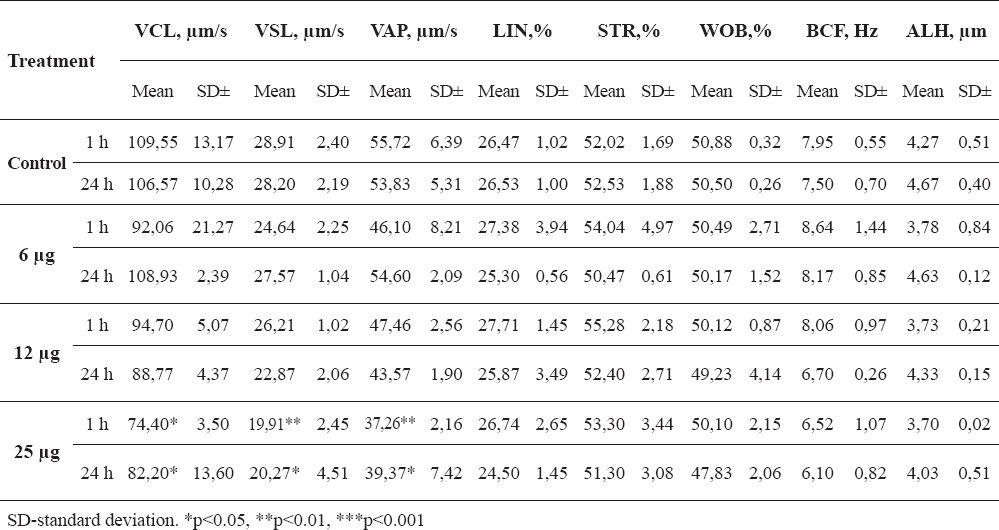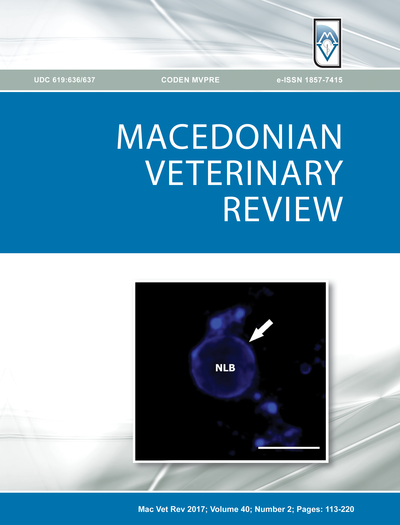INTRODUCTION
Artificial insemination (AI) is very important for modern pig farming. In comparison to natural mating, AI allows obtaining a greater litter size per sow by using sires with better fertility and genetic qualities. Among the main goals of the specialists in pig reproduction is achieving an even better conception rate after AI. A lot of research has been focused on the addition of different compounds to the semen extenders, which can protect and preserve sperm motility and integrity for a prolonged period, or can enhance the sperm movement, through the female reproductive tract. One of the compounds with such potential is prostaglandin F2α (PGF2α). In sows, PGF2α and its analogues have been widely used for synchronization of estrus (1), inducing of parturition (2) or abortion (3) and to reduce the weaning-to-estrus interval (4). The administration of PGF2α in boars can improve the training of sexually active boars for semen collection (5), and increase the volume and the total number of sperm in the sperm rich fraction (6). Another asset of PGF2α is the fact that it can increase myometrial contractility (7). Subsequently, this will facilitate the sperm movement through the female reproductive tract. Kos and Bilkei (8) demonstrated that boar semen supplemented with PGF2α immediately before insemination improves the conception and farrowing rates, as well as regular returns to estrus in the inseminated sows. The amount of endogenous PGF2α in boar semen is less than 100 pg/ml, which is insufficient to increase myometrial contractility (9), so addition of exogenous PGF2α is needed for obtaining this beneficial effect. For the reasons mentioned above, the supplementation of boar semen with PGF2α or its analogues can be beneficial for the success of AI in pigs.
However, there is a question arising: What is the effect of PGF2α or its analogues on sperm motility parameters, when added to extended boar semen? In an experiment with boars from the Landrace breed, the addition of PGF2α led to an increase of sperm motility to over 80% while the control group had motility of 65-70% (10). In another study, the administration of PGF2α in semen from Pietrain boar did not increase the semen motility parameters (11).
The aim of current study was to define if there are changes in motility, morphology and kinematic parameters of spermatozoa on 1st and 24th hour after addition of PGF2α analogue (cloprostenol, Oestrophan, Bioveta, CZ) to extended boar semen.
MATERIAL AND METHODS
Semen collection
The ejaculates (n=18) were collected manually (gloved-hand technique) from clinically healthy Danube white breed boars, at the age of 2.5 years. The semen was collected twice per week in accordance with regulatory requirements for breeding in pigs.
Sperm motility and kinematic parameters
Sperm concentration, total motility, progressive motility, rapid velocity as well as kinematic parameters - Curvilinear Velocity (VCL); Straight-line Velocity (VSL); Average Path Velocity (VAP); Linearity (LIN); Straightness (STR); Wobble (WOB); Amplitude of lateral head displacement (ALH) and Beat/Cross Frequency (BCF) were evaluated by a computer-assisted sperm analyzer (CASA) (SCA, Microptic, Spain)
Sperm morphology
Sperm smears were prepared on preparation glass and stained by Sperm Blue (Microptic, Spain), performed according to the manufacturer’s protocol. The sperm morphology was evaluated under microscope (Nikon Eclipse E200, Japan) under a bright field with magnification of ×40.
Experimental design
Each ejaculate was evaluated under a microscope immediately after obtaining and those not complying with standard requirements were discarded. Subsequently, they were diluted 1:3 in semen extender “Sredetz” and transferred to the laboratory. Each ejaculate was separated into four aliquots, 50 ml each. PGF2α analogue (cloprostenol, Oestrophan, Bioveta, CZ) was added to 3 of them in concentrations of 6, 12 and 25 µg/ml, and the fourth served as untreated control. The samples were stored at 15°C before the evaluations. The motility, kinematic parameters and morphology of spermatozoa were assessed at 1st and 24th hours after addition of PGF2α.
Statistical analysis
Values were presented as mean ± standard deviation. The statistical analyses were performed by software R 2.10. All data was tested for variance using ANOVA and then experimental treatments were compared to the untreated control using Dunnett t-test (p≤0.05).
RESULTS
The present study was focused on the evaluation of the effect of PGF2α analogue cloprostenol on motility characteristics and morphology of spermatozoa, when added to extended boar semen. The motility and morphology of the spermatozoa at the 1st and the 24th hour after PGF2α analogue administration are presented in Table 1. There was a decrease in the percent of spermatozoa with progressive motility in the experimental groups compared to the control in both time points, which however was not statistically significant (p>0. 05). The rapid velocity also decreased in time more rapidly in PGF2α treated groups than in control, but statistical significance was observed only at the 1st hour post treatment with 25 µg/ml (p=0,019). There was no significant difference in the percent of spermatozoa with normal morphology between the untreated and treated groups, at both time periods.
Table 1. Effect of PGF2α analogue on motility and morphology of boar spermatozoa at the 1st and 24th hour after administration in the extended semen (n=18)
There was no statistically significant difference in the kinematic parameters of boar spermatozoa in the control and the groups treated with 6 or 12 µg/ml PGF2α analogue (Table 2). The addition of 25 µg/ml PGF2α analogue to boar semen led to a statistically significant decrease in some of the kinematic parameters of the spermatozoa - VCL (p=0.025), VSL (p=0,002) and VAP (p=0,008) at the 1st hour after treatment, while the other LIN, STR, WOB, BCF and ALH remained unchanged (Table 2). Similar results were observed at the 24th hour, with some changes in the level of significance - VCL (p=0.025), VSL (p=0,02) and VAP (p=0,015). Again, the other kinematic parameters remained unchanged.
Table 2. Effect of PGF2α analogue on kinematic parameters of boar spermatozoa at the 1st and 24th hour after administration in the extended semen (n=18)
DISCUSSION
Our results indicate that administration of PGF2α analogue (Oestrophan, Bioveta, CZ) at doses of 6 and 12 µg/ml in extended boar semen did not affect the total and progressive motility and the percent of rapid velocity spermatozoa of Danube white boars, at the 1st and 24th hour after treatment. Similarly to our results, Maes et al. (11) found no improvement in motility and kinematic parameters of the spermatozoa after addition of PGF2α (Dinolytic; Pharmacia Animal Health; 5 mg PGF2α/ml) in doses of 2.5, 5 or 10 mg PGF2 α to 100 ml diluted sperm form Pietrain boars. In another study, Pandur and Pacala (10) found that the addition of 1 ml PGF2α (Dinolytic®; Pfizer; 5 mg PGF2α/ml) to 100 ml semen from Landrace boars, right after dilution, lead to increase in sperm motility. The difference between our findings and those of Pandur and Pacala (10) might be contributed to the different breed and the different extender that were used, the different time of motility evaluation (immediate PGF2α addition in theirs, and at the 1st and 24th hour after treatment in our experiment) or the fact that the sperm motility assessment in their work, was performed not by CASA but by a technician on a phase-contrast microscope.
Yeste et al. (12) supplemented extended semen from Pietrain boars with PGF2α (Dinolytic®, Pharmacia, 5mg PGF2α/ml) in concentrations of 0.625, 1.25, 2.50, 5, 10, 12.50, 25 and 50 mg PGF2α to 100 ml semen, and assed the sperm quality immediately after treatment, and after 1, 3, 6 and 10 days. They found that treatments with PGF2α in concentrations higher than 12.5 mg/100 ml were cytotoxic, while the others did not damage boar spermatozoa. None the less, the addition of PGF2α at 5 mg/100 ml to sperm diluted in BTS extender may maintain sperm viability and motility better after 6 days of cooling, compared with control at the same time.
Also It was found that administration of 0.25 or 2.5 µg cloprostenol per 1ml diluted boar semen had no impact on boar sperm motility, while concentrations higher than 5 µg had a negative effect (13).
In our study the concentration of 25µg/ml PGF2α analogue (Oestrophan, Bioveta, CZ) leads to a significant decrease in some of the kinematic parameters of the sperm at the 1st and the 24th hour after treatment. Additionally, the same concentration affects negatively the percent of rapid velocity spermatozoa at 1st hour after treatment. The other treatments have no negative effect on the sperm motility, morphology and kinematic parameters.
Our findings suggested that PGF2α analogue cloprostenol supplementation to extended boar semen has no positive effect on sperm motility and kinematic parameter. The obtained data is in agreement with most of the other research work in the area (11, 12, 13, 14), despite the fact that we used cloprostenol (Oestrophan, Bioveta, CZ) – a synthetic analogue of PGF2α, while in some of the other research work dinoprost tromethamine was used – a naturally occurring prostaglandin F2α. The above mentioned suggests that even if the origin of the PGF2α analogues is different, the effect on boar semen is similar. The decrease in kinematic parameters and subsequently in rapid velocity which occurs with higher concentration of cloprostenol may be due to different factors like mitochondrial transformation or induced sperm membrane damage. Similarly, the concentration of cloprostenol higher than 300 μg /ml of diluted bull semen leads to decrease in sperm motility and even induces sperm membrane damage and permeability (14).
CONCLUSION
The results indicate that addition of PGF2α analogue cloprostenol to the extended boar semen did not improve the sperm motility, morphology and kinematic parameters of the spermatozoa from Danube white boars. The positive effect of PGF2α on the conception and farrowing rates, demonstrated by other research work which included supplementation of PGF2α analogues to boar semen prior AI, can be contributed to other factors (e.g. increase myometrial motility), but not to improvement of sperm intrinsic movement.
CONFLICT OF INTEREST STATEMENT
The authors declared that they have no potential conflict of interest with respect to the authorship and/or publication of this article








